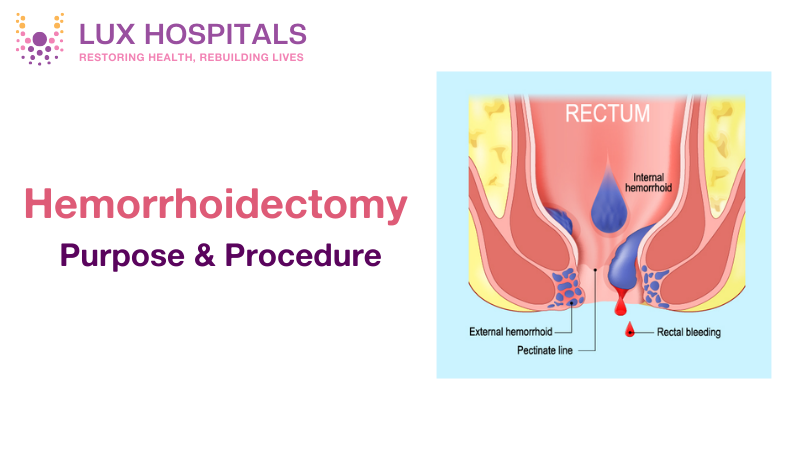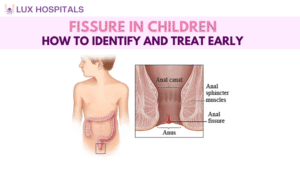Hemorrhoidectomy: A Guide to Purpose and Procedure

Hemorrhoids are a painful and bothersome condition affecting millions of people worldwide. When non-surgical treatments fail to provide relief, a Hemorrhoidectomy may be recommended. This surgical procedure offers effective and long-lasting results, helping individuals regain comfort and improve their quality of life. In this article, we are going to discuss what a Hemorrhoidectomy is, what it means, types, surgical options, possible complications, and tips for healing.
What is Hemorrhoidectomy?
A Hemorrhoidectomy is a surgical procedure to excise hemorrhoids—enlarged and inflamed veins inside the rectum or anus. Hemorrhoids can lead to pain, itching, bleeding, and pain on defecation.If the non-operative treatments, like adjustments in lifestyle, dietary change, or regional drugs, fail, a Hemorrhoidectomy may be performed.
The procedure safely removes internal or external hemorrhoids, providing total relief and precluding future complications.
Purpose of Hemorrhoidectomy
The main purpose of a Hemorrhoidectomy is to relieve the hemorrhoid pain and symptoms. It is advised in the following situations:
Severe Hemorrhoids: When hemorrhoids are big, painful, and bleed heavily.
Prolapsed Hemorrhoids: When hemorrhoids bulge out of the anus and cannot be pushed back inside them.
Chronic Bleeding: Recurring bleeding from hemorrhoids, causing anemia or other health issues.
Failed Conservative Therapy: In case modification of lifestyle, medications, or nonoperative management is of no relief.
Usually, Hemorrhoidectomy is done to improve the patient’s life by keeping the patient relieved from discomfort or pain during any routine activity.
Types of Hemorrhoidectomy
There are a number of Hemorrhoidectomy surgeries, each of which is specific to the patient’s condition. Let us discuss the most prevalent ones:
Traditional (Open) Hemorrhoidectomy: This is the old method where the hemorrhoidal tissue is removed, and the wound is allowed to heal by itself. It is very effective for large or complicated hemorrhoids but can take a longer recovery time and cause pain.
Stapled Hemorrhoidectomy: PPH is another term for the procedure in which hemorrhoidal tissue is removed with a circular stapling instrument with the realignment of the rest of the tissue. The blood supply to the hemorrhoids is cut off, and it decreases their size while producing fewer pains and quicker healing.
Laser Hemorrhoidectomy: A minimally invasive procedure in which laser energy decreases or eliminates hemorrhoidal tissue. The laser vaporizes blood vessels, reducing bleeding and healing more quickly. It provides accuracy, less pain, and less recovery time.
Closed Hemorrhoidectomy: The surgeon removes the hemorrhoidal tissue and closes the wound by suturing using this technique. It is used for small hemorrhoids and has a faster healing time compared to the open method.
Each technique of Hemorrhoidectomy has advantages and disadvantages. The operation depends on the severity of the hemorrhoids, the overall condition of the patient, and the expertise of the surgeon.
Hemorrhoidectomy Procedure
Understanding what the Hemorrhoidectomy procedure is can alleviate worry and prepare one for what is ahead:
Preoperative Preparation: The patient is thoroughly evaluated prior to the operation, with a medical history, physical examination, and investigations as required. Bowel preparation and dietary adjustment may be advised for an uneventful procedure.
Anesthesia: Hemorrhoidectomy is most commonly done under local, spinal, or general anesthesia, depending on the condition of the patient and the preference of the surgeon.
Surgical Technique: The surgeon removes the hemorrhoidal tissue using whichever technique is elected—open, closed, stapled, or laser. Hemorrhoidectomy. The site is cleaned and closed if needed.
Duration: This procedure lasts for 30-60 minutes based on the volume of hemorrhoids and the technique used.
Postoperative Care: They are observed for early postoperative complications and given pain relief medication. They are discharged on the same day or the following day, depending on their status.
Complications of Hemorrhoidectomy
Although Hemorrhoidectomy is safe and effective in most cases, as with any surgery, there are risks and complications involved with it, such as:
Pain and Discomfort: It is normal to experience pain following Hemorrhoidectomy, particularly with bowel movements. Pain relief is taken to alleviate discomfort.
Bleeding: It is normal to experience slight bleeding, but a doctor can control significant bleeding.
Infection: Infrequently, the wound might become infected and will need antibiotics.
Urinary Retention: Transient inability to urinate due to swelling or pain.
Stenosis: Narrowing of the anal canal might happen, causing pain and straining during defecation.
Recurrence: Hemorrhoidectomy provides long-lasting relief, yet hemorrhoids could recur if prevention is not adopted.
It is important to adhere to the surgeon’s post-operative directions to avoid developing complications and ensure smooth recovery.
Conclusion
A Hemorrhoidectomy is a very effective surgery that offers permanent relief from painful and embarrassing hemorrhoids. As there are various types to choose from, such as stapled Hemorrhoidectomy, laser and open Hemorrhoidectomy, and a couple more, the surgery can be adjusted based on each patient’s individual requirements.
Knowing the purpose, method, possible risks, and successful Hemorrhoidectomy recovery methods can enable the patients to make informed decisions and prepare for a complication-free recovery process.
If you continually experience hemorrhoid symptoms and conservative treatment has not worked, explore the option with a medical practitioner for deciding whether or not to have a Hemorrhoidectomy.
Frequently Asked Questions
Yes, a hemorrhoidectomy is considered a major surgery as it involves the removal of hemorrhoidal tissue. It requires anesthesia and a recovery period but is generally safe and effective for severe cases.
Yes, piles can come back after a hemorrhoidectomy if preventive measures like a high-fiber diet, proper hydration, and avoiding straining during bowel movements are not followed.
Bed rest is typically recommended for the first 1 to 2 days after hemorrhoid surgery, but most patients can resume light activities within a week, depending on their recovery and doctor’s advice.
The procedure typically takes 30 to 60 minutes, depending on the complexity and the surgical technique used.
Possible complications include pain, bleeding, infection, urinary retention, anal stenosis, and in rare cases, recurrence of hemorrhoids. Following post-operative care instructions reduces the risk of complications.
Preparation includes a medical evaluation, dietary adjustments, and bowel cleansing as recommended by the surgeon. It is essential to follow preoperative instructions for a smooth procedure.
You should contact your doctor after a Hemorrhoidectomy if you experience severe pain, excessive bleeding, signs of infection (fever, redness, or discharge), or difficulty in urination. At Lux Hospitals, we provide the best treatment and post-operative care to ensure a smooth recovery.




















